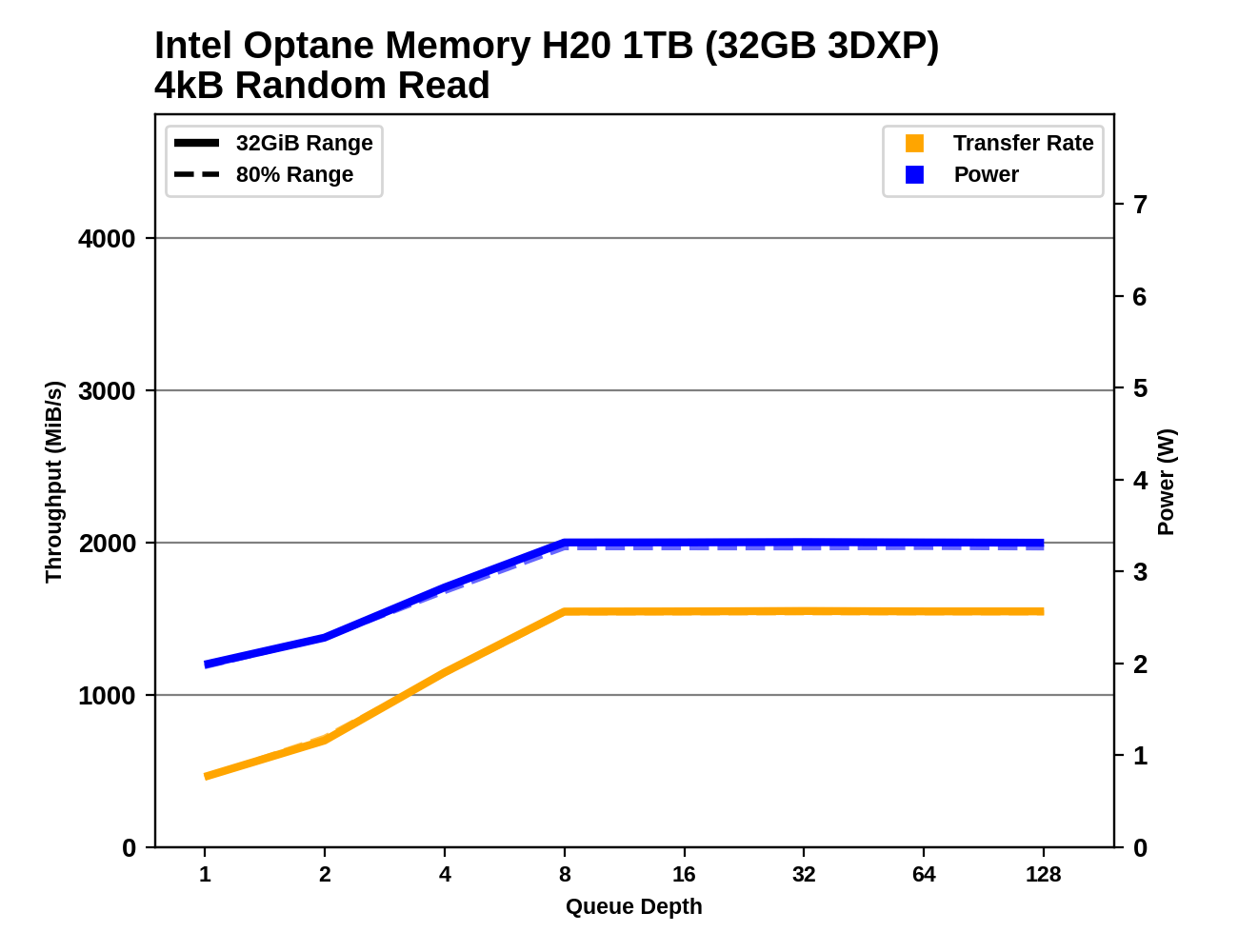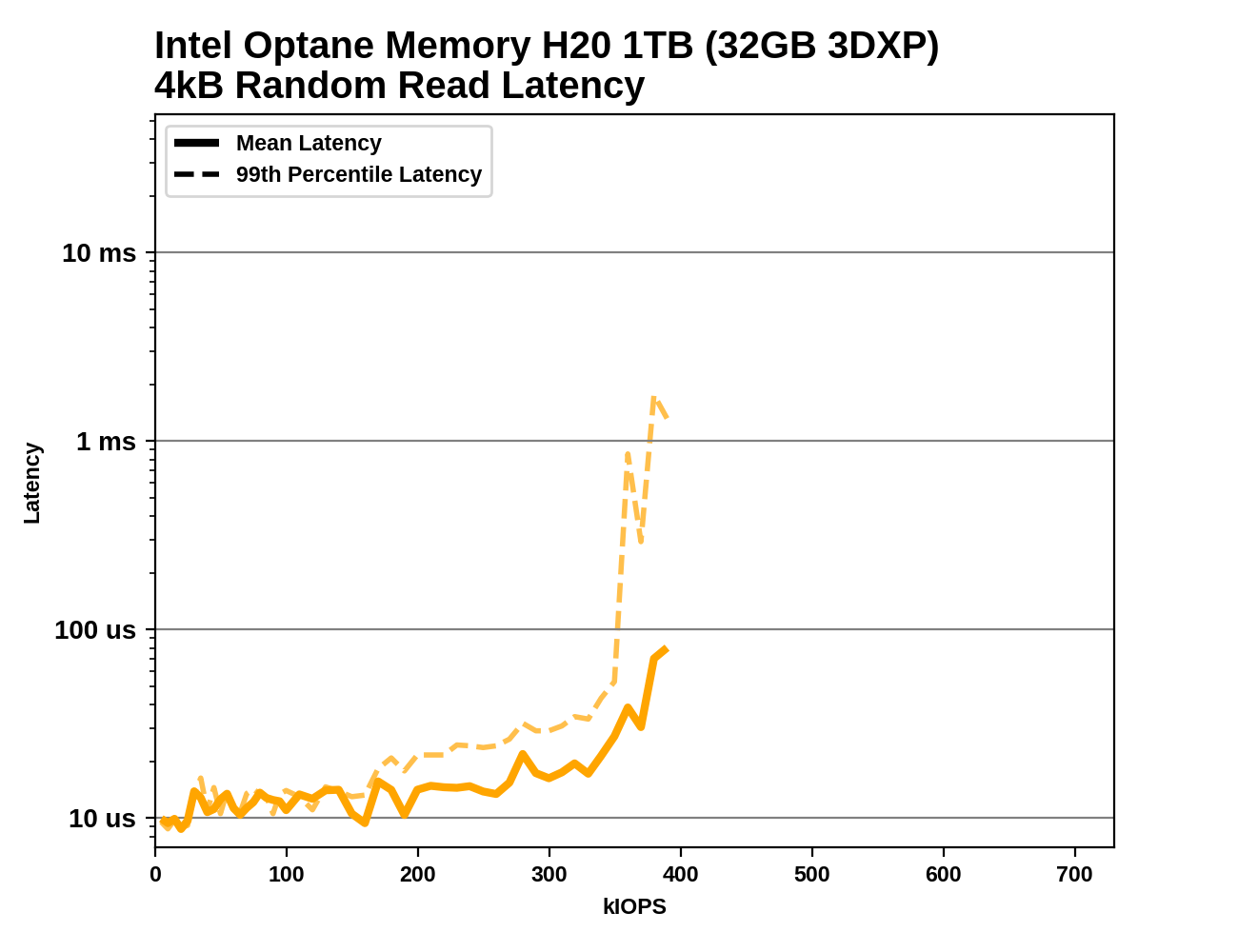Caching And Tiering: Intel Optane Memory H20 and Enmotus FuzeDrive SSD Reviewed
by Billy Tallis on May 18, 2021 2:00 PM EST- Posted in
- SSDs
- Storage
- Intel
- SSD Caching
- 3D XPoint
- Optane
- Optane Memory
- Tiger Lake
Our suite of Linux-based synthetic tests cannot directly measure how the Intel Optane Memory H20 or Enmotus FuzeDrive SSD behave when used with their respective caching or tiering software, but we can investigate how the individual components of those storage systems perform in isolation. The tests on this page are all conducted on our usual AMD Ryzen testbed.
Burst IO Performance
Our burst IO tests operate at queue depth 1 and perform several short data transfers interspersed with idle time. The random read and write tests consist of 32 bursts of up to 64MB each. The sequential read and write tests use eight bursts of up to 128MB each. For more details, please see the overview of our 2021 Consumer SSD Benchmark Suite.
 |
|||||||||
| Random Read | Random Write | ||||||||
| Sequential Read | Sequential Write | ||||||||
The Intel Optane cache devices still have a huge lead over other storage technologies for random read performance, but the most notable improvements the Optane Memory H20 makes over the H10 are for random and sequential writes, where the little Optane devices most drastically underperform NAND SSDs. The small 32GB cache is now almost as fast as the 118GB Optane 800P was, but that's still not enough to match the performance of a decent-sized NAND SSD.
The SLC portion of the Enmotus FuzeDrive SSD doesn't particularly stand out, since these burst IO tests are mostly operating out of the SLC caches even on the regular NAND SSDs. However, the static SLC does clearly retain full performance on these tests even when full, in stark contrast to most of the drives that rely on drive-managed SLC caching.
Sustained IO Performance
Our sustained IO tests exercise a range of queue depths and transfer more data than the burst IO tests, but still have limits to keep the duration somewhat realistic. The primary scores we report are focused on the low queue depths that make up the bulk of consumer storage workloads. For more details, please see the overview of our 2021 Consumer SSD Benchmark Suite.
 |
|||||||||
| Random Read | Throughput | Power | Efficiency | ||||||
| Random Write | Throughput | Power | Efficiency | ||||||
| Sequential Read | Throughput | Power | Efficiency | ||||||
| Sequential Write | Throughput | Power | Efficiency | ||||||
There are no big changes to note for the Optane cache device on these longer-running tests that bring in some higher queue depths. The main advantages of Optane devices are at low queue depths, especially the QD1 that was already covered by the burst IO tests. The SLC portion of the Enmotus FuzeDrive does start to show some performance loss on the write tests when it is mostly-full, illustrating that SLC NAND is not immune to the performance impacts of background garbage collection with time-consuming block erase operations.
 |
|||||||||
| Random Read | |||||||||
| Random Write | |||||||||
| Sequential Read | |||||||||
| Sequential Write | |||||||||
Digging deeper into the performance results, the Optane portion of the H20 shows the results we expect, reaching its full performance at fairly low queue depths and showing high consistency.
The SLC portion of the Enmotus FuzeDrive SSD shows many of the characteristics we're used to seeing from NAND-based SSDs, including the common Phison trait of poor sequential read performance at low queue depths.
Random Read Latency
This test illustrates how drives with higher throughput don't always offer better IO latency and Quality of Service (QoS), and that latency often gets much worse when a drive is pushed to its limits. This test is more intense than real-world consumer workloads and the results can be a bit noisy, but large differences that show up clearly on a log scale plot are meaningful. For more details, please see the overview of our 2021 Consumer SSD Benchmark Suite.
 |
|||||||||
The Optane cache on the H20 can't beat the maximum random read throughput available from a mainstream or high-end TLC SSD, but until the Optane hits its throughput limit it has unbeatable latency. The SLC portion of the Enmotus FuzeDrive SSD not really any faster on this test than a good TLC drive.










45 Comments
View All Comments
powerarmour - Tuesday, May 18, 2021 - link
QLC garbage again, I can hardly contain myself.Samus - Wednesday, May 19, 2021 - link
Understanding QLC's place in the market (cheap bulk flash storage) I'm also struggling to understand who these premium-priced QLC products are for. Seriously who is going to pay 23-25¢/GB for something like this when it's only crutch is high read throughput that has zero real world advantage for virtually all PC users.Wereweeb - Wednesday, May 19, 2021 - link
These products are both proofs of concept, and an advertising for the importance of Caching/Tiering.Enmotus managed to get 3600 TBW out of a 2TB QLC SSD by reducing it's available capacity by a bit and using their software.
philehidiot - Wednesday, May 19, 2021 - link
There is definitely the endurance advantage, but you don't need a commercial product for proof of concept. Indeed, I'd say releasing a commercial product just to prove it can be done where there is no real use for it is a bit daft. Unless they plan to inflict it upon customers in a data collection exercise, using their muscle to force it into laptops. We have already seen the advantages of this kind of tech when smaller SSDs were placed as a cache / tier into HDDs.If their plan is to build this into an industrial product, their proof of concept should be a bunch of engineering samples tested for endurance, not a bodged consumer grade product which seems as though it's going to do more to show you can have a very complex and bodged product and it just about compete with what's already established on the market.
As for advertising, I'd say this is a pretty poor advert. Someone mentioned that Intel's storage division has been held back and it strikes me this is the case. This isn't a new and exciting product, it's two technologies being put together with an inadequate hardware interface and terrible software.
It has potential, but the people who will accept QLC NAND won't know or care what this is and the people who might benefit from the high DWPD won't touch it with a barge pole.
This should have stayed in R&D until it could add something to the market.
Samus - Thursday, May 20, 2021 - link
I'll believe it when it's independently tested. No level of software trickery will enable massive gains in TBW. If you fully write to a drive, the physical cells are fully utilized. Sure you can mask this with a large spare area and aggressive wear leveling but even a 2TB QLD SSD with 4TB of physical NAND (so 2TB spare area) will only yield 4x the endurance and that's best case scenario.Enmotus can't break the laws of physics with intelligent software unless they've come up with some revolutionary hardware deduplication\compression algorithm that is limiting physical changes to NAND by many orders of magnitude, while also eliminating write amplification that is essential to modern ECC for data integrity.
Billy Tallis - Thursday, May 20, 2021 - link
The key advantage the Enmotus drive has over regular QLC drives is that the static SLC portion can be used for far more P/E cycles. On a regular QLC drive, which blocks are used for the dynamic SLC cache is constantly changing, and the fact that a block that's currently operating as SLC may soon be repurposed as QLC effectively prevents it from being rated for more P/E cycles than QLC usage can permit. But with a large pool of permanent SLC, the drive can safely re-use those cells long past the point where they would be unusable as QLC. 128GiB at 30k P/E cycles can on its own handle more total writes than the drive as a whole is rated for.As long as the tiering software does a good job of preventing most writes and write amplification from ever getting to the QLC part of the drive, the endurance rating is completely realistic. The tiering software won't be able to keep the wear confined to the SLC if you are using the drive as a giant circular buffer for video recording or something else that keeps the drive full and constantly modifies all of the data. But most real consumer workloads have a small amount of hot data that's frequently changing and a large amount of cold data that doesn't get rewritten often enough to pose a problem for QLC.
Spunjji - Wednesday, May 19, 2021 - link
Agreed - this would really need to show a serious performance benefit at a similar cost to a TLC drive, or lower cost and similar performance. As it is, it does neither. I'm sure OEMs will lap it up at whatever knockdown price Intel offers it to them to clear the shelves.Spunjji - Wednesday, May 19, 2021 - link
Derped there and confused the price of the Enmotus with the H20... the Enmotus product really does seem to be in a bad place for price vs. consumer appeal without the benefit of Intel's cosy relationship with OEMs.Morawka - Friday, May 21, 2021 - link
The Enmotus product is perfect for Chia miners. Plotting on Chia absolutely destroys consumer-grade SSD's. A 980 Pro will get smoked in around 3 months, whereas this Enmotus drive, even though it's pricier, will last 3-5x longer.Billy Tallis - Friday, May 21, 2021 - link
I think Chia plotting requires more space than the SLC portion of the Enmotus drive, and plotting is an example of the kinds of workloads that would not be handled well by the Enmotus tiering software unless the plotting could fit entirely in the SLC tier.